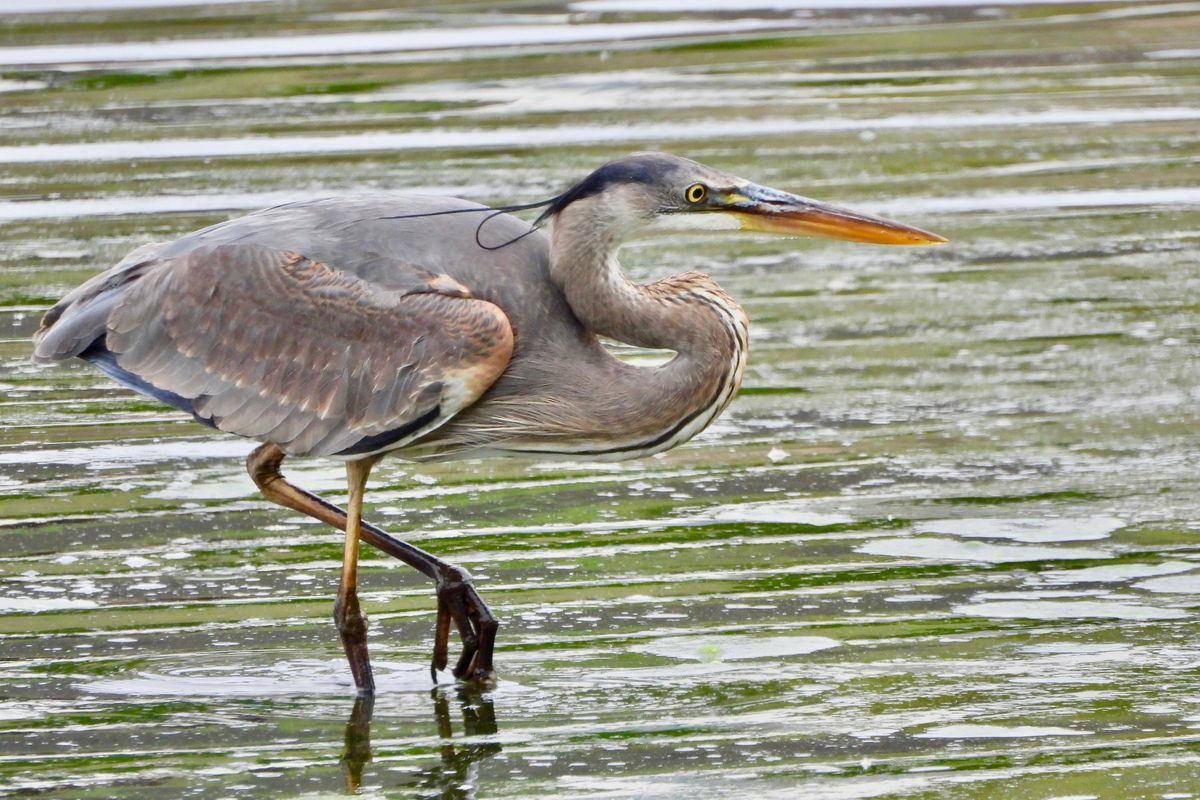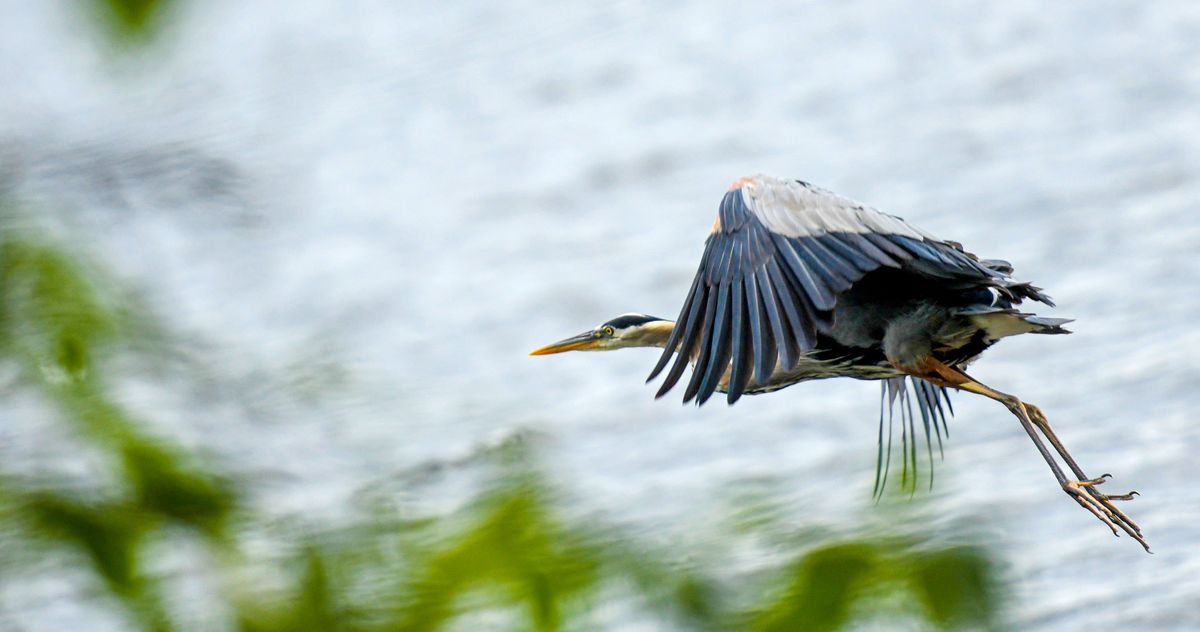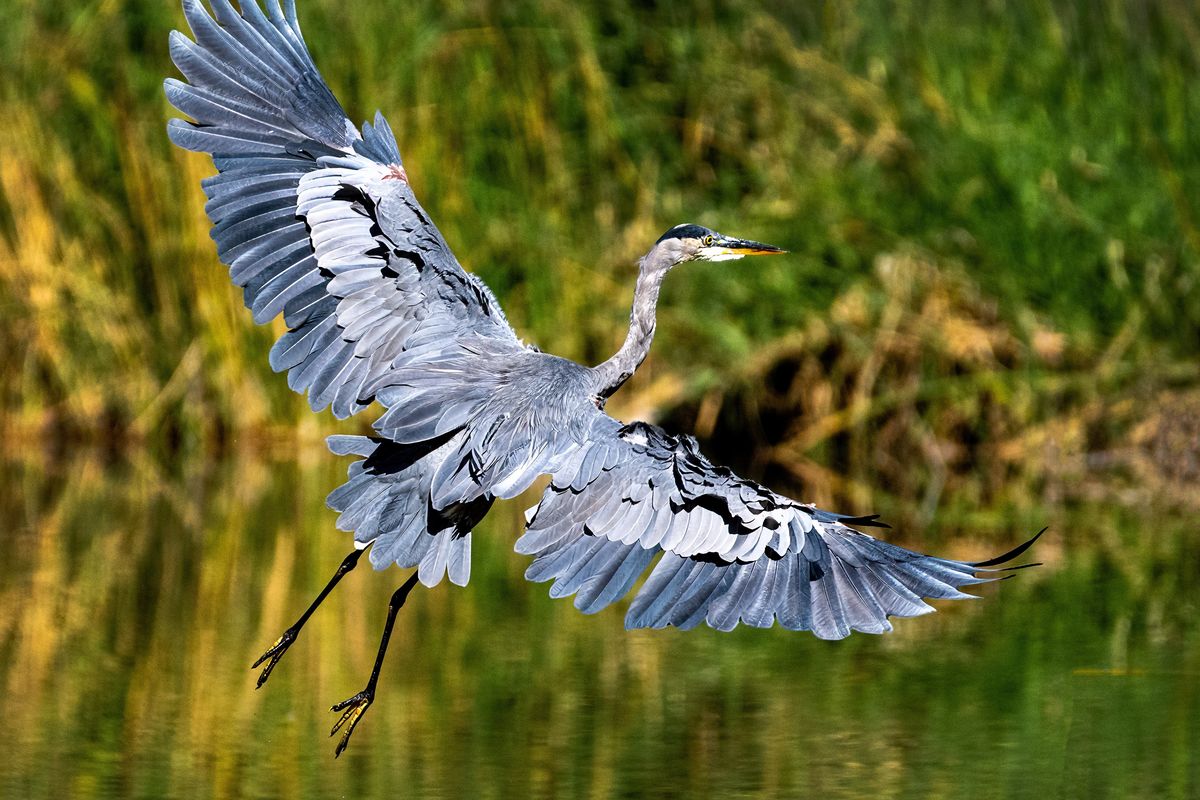Cool Critters: The patient, magnificent and primitive great blue heron
A great blue heron flies over a stormy Hauser Lake on July 3, 2022. (Kathy Plonka/The Spokesman-Review)
The great blue heron, as tall as a 7-year-old child and boasting a 6-foot wingspan, is among the largest and most distinctive birds you will see in the Inland Northwest or anywhere in the United States.
Happily for us, this supersized bird is often seen along lakes, rivers, streams and ponds in our area. Whether standing still in shallow water or flapping its huge wings in flight with two spindly legs trailing behind, it’s hard not to gawk. Besides being large, it is equal parts elegant and prehistoric.
The great blue heron is also, well, blue. No, not cobalt or sky blue, but grayish blue. Although a subtle shade, “blue is not common in nature,” said wildlife biologist Mark Vekasy of the Washington Department of Fish and Wildlife. Another distinct color pattern is its whitish face with a wide black stripe that extends from above each eye to the back of the head, he added.
Not to mention the bird’s spindly, rust-colored legs or its dagger-shaped yellowish-orange bill.
Great blue herons are so distinctive looking that “people have been drawing, painting and photographing them for years and years,” Vekasy said. “They definitely get attention.”
If human onlookers are quiet enough, the birds make good models. They can resemble statues erected in shallow waters, standing motionless for long periods while using their keen eyes to scan for their next meal of mostly fish, but also frogs, crabs and snakes.
In a 2021 study published in the journal BioScience, “Who’s Observing the Observers?”, the great blue heron was the fourth most observed species uploaded to the nature app, iNaturalist over an 11-year span. Analyzing data from the platform’s 1.7 million nature-enthusiast users, the 10 most recorded animals “tended to be species that are easily observed by virtue of their size, behavior, and conspicuousness,” the authors wrote. (The monarch butterfly placed first and the Western honeybee a close second.)
Back to that statuesque heron scanning the water for food. When a small fish gets relatively close, the bird sneaks up on it by lifting one lanky leg at a time (those legs account for about half of the bird’s 4-foot height), barely making a ripple as it moves through the water, said wildlife biologist Rod Sayler of Washington State University.
“It’s fascinating to watch them slow-motion wade through shallow water as they stalk fish and other animals,” said Sayler, who’s encountered a “great many” great blue herons during his nearly five decades of field work on birds. Consequently, he has witnessed how the bird’s patience and slow, methodical movements lead to its next meal.
Once within striking distance, the great blue heron uncoils its long S-shaped neck forward and plunges its powerful bill into the fish – typically in a matter of seconds. Then it tosses its head back and swallows the critter whole down its long, slender neck.
Great blue herons are mostly solitary birds, except for during breeding and nesting season which starts in early spring. That’s when they congregate into colonies known as rookeries, where they build large nests in treetop clusters near bodies of water. In these waterfront avian communes, adult birds take turns guarding for predators such as owls and hawks aiming to prey on eggs or chicks. Sometimes they establish rookeries in human-made structures such as I-beams along bridges, said Vekasy of the Department of Fish and Wildlife .
Now that it’s late August, the adults and their young have flown from their rookeries to live on their own. Adults typically return to the same rookery in the spring, refurbishing nests from previous years.
For now, some herons will migrate southward to California, Arizona and Nevada for winter, Vekasy explained, while others will remain in the Inland Northwest.
Because frozen water prevents them from accessing their primary food sources, “habitat-wise, there’s not enough to maintain heron populations year-round,” he said. The herons that stay put during winter typically hunt for fish among patches of open water in the ice. When fish are in short supply, they move to land to feast on mice and voles.
“A lot of people don’t realize how many small mammals they eat,” Vekasy said.
So, if you spot a motionless, leggy bird towering in a snow-laden field one day, you’ll know it’s likely a great blue heron who resides year-round in the Inland Northwest. Watching. Waiting.
Or maybe you’ll see one flying with giant wings flapping, its long neck curved into an S shape and two sticklike legs extending straight beyond its fanned-out tail feathers. In flight, the bird resembles a great winged creature from prehistoric times.
Granted, the great blue Heron didn’t live alongside Tyrannosaurus rex 66-million years ago, but the bird’s oldest fossils date back to 14 million years, meaning it is an old species, indeed.
The bird’s ancient air can be heard in its raspy call as it takes flight, said Sayler of WSU.
“To me, the ‘croak’ of a great blue heron makes me think of what an ancient pterodactyl might have sounded like,” he said.



